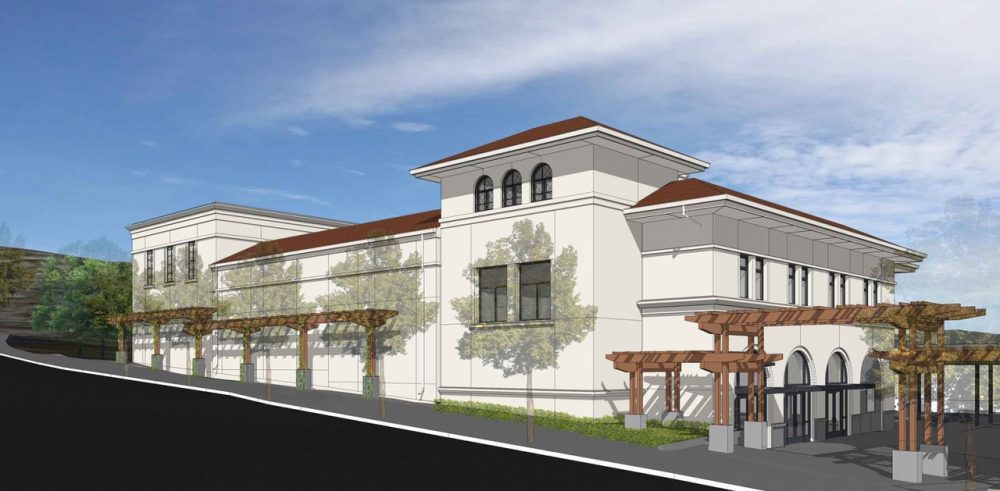Superintendent Randy Booker sent the following update to Piedmont families on the last day of school, May 31.
History of the Measure H1 Bond Program
During 2015-16, the Piedmont Unified School District assessed its facilities to determine whether they support changing educational programs and goals, and developed a plan to ensure that facilities enhance educational programs now and in the future. This “Facilities Master Plan” is intended to address current and future educational needs of students and ensure that facilities provide both the functionality and capacity to support educational excellence. (For more information about the development and content of the Facilities Master Plan, see http://measureh1.org.)
Among other findings, the Facilities Master Plan states that many of the middle and high school building systems have reached the end of their useful life and should be replaced. Also, educational needs have changed since the middle and high schools were constructed, and both additional and different kinds of facilities are needed. Since these school buildings were constructed, course offerings have become more varied and some courses require specialized classrooms and labs – particularly in the fields of science, technology and engineering. Course work now incorporates collaboration in small groups and presentations, but undersized classrooms and heavy, inflexible furnishings make it difficult to reconfigure classrooms to support these activities. Lab work requires safe and suitable space for group projects and project storage, and inadequate labs, in fact, constrain teaching and learning opportunities. Additional specialized facilities are needed to offer or expand courses in film, web design, theater arts (including set and lighting design), graphic arts, culinary arts, and sports medicine, among others. At the time, completing the work identified in the Plan was estimated to cost roughly $137 million.
To address the most pressing needs identified in the Facilities Master Plan, the District proposed Measure H1 to the Piedmont voters. On November 8, 2016, 74% of the voters approved the measure, authorizing the District to borrow $66.1 million to begin implementing the Plan.
Program Timeline and Milestones
2015-16 Development of PUSD Master Plan
2016
November Voter approval of Measure H1
2017
February Selection of HKIT Architects
April Town Hall Meetings, Community Input on Concept Designs for STEAM, new Alan Harvey Theater
May-September Schematic Design Development, Input from Educators, Staff, Students
September-October Presentation of Schematic Designs to the Community
October-December Design Development
December Selection of General Contractor, Begin Pre-construction Services
2018
January-July Development of Construction Documents, Conduct Constructability Analysis and Value Engineering
July Submittal of STEAM Construction Documents to DSA
September Submittal of Theater Construction Documents to DSA
2019
February-March Projected DSA Approval, Negotiation of Guaranteed Maximum Price
March Closure of Alan Harvey Theater, Salvage and Abatement Begins
April Demolition of Alan Harvey Theater Begins
June Construction of STEAM building begins
2020
June Demolition of the 10s Building, Construction of new Performing Arts Building begins
July Completion of STEAM building
August Opening of the STEAM Building, Relocation of Classrooms
2021
Fall Opening of the new Performing Arts Building housing the new Alan Harvey Theater
Program Overview: Accomplishing Key Objectives
Since the passage of Measure H1, the District has completed the following:
- Installation of new heating and cooling systems in 15 classrooms at the elementary schools (thermostat data was used to identify the classrooms in greatest need of climate control).
- Improvements to the learning environment at the middle school, including the reduction of sound transfer in classrooms and improved climate control.
- Renovation of special education facilities and restrooms at the middle school.
- Installation of new safety and security features at the middle and high schools consistent with the District’s Safe Schools Plan.
- Creation of a new high school computer lab.
Over the next few years, the District is on track to complete several more projects, including:
- Construction of a new high school STEAM building for the study of Science, Technology, Engineering, Art, and Mathematics (see architect renderings below).
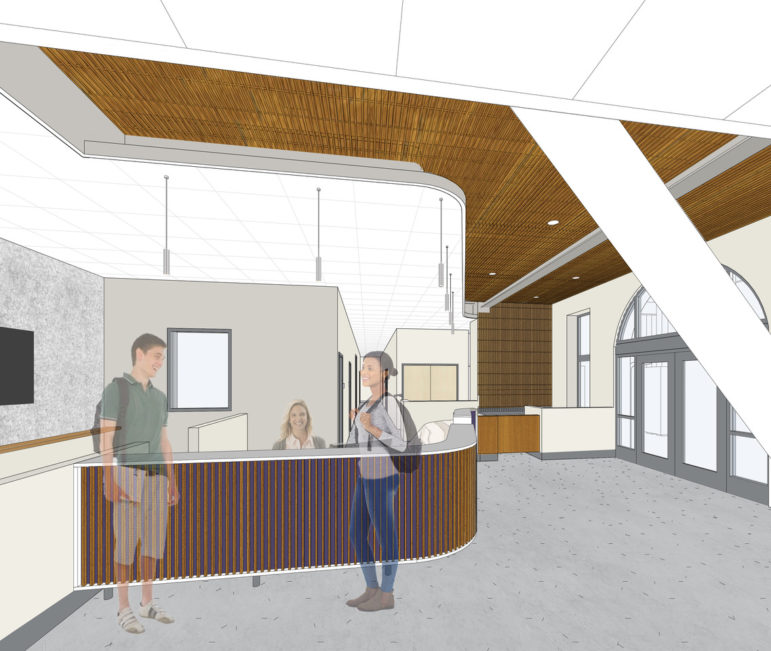
STEAM lobby 
Corridor in STEAM building 
Science classroom
- Construction of a performing arts building with a new 487-seat Alan Harvey Theater and a drama classroom (see architect renderings below).
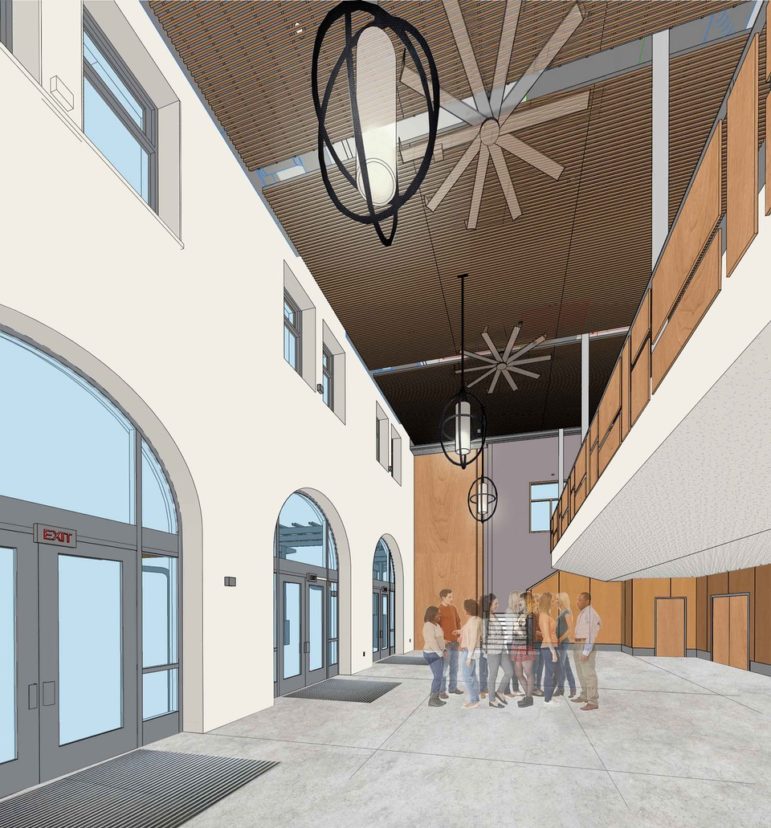
Theater lobby 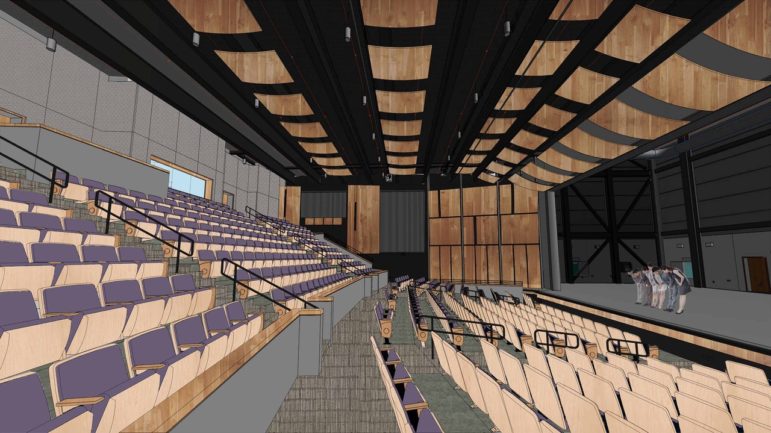
Audience seats in theater 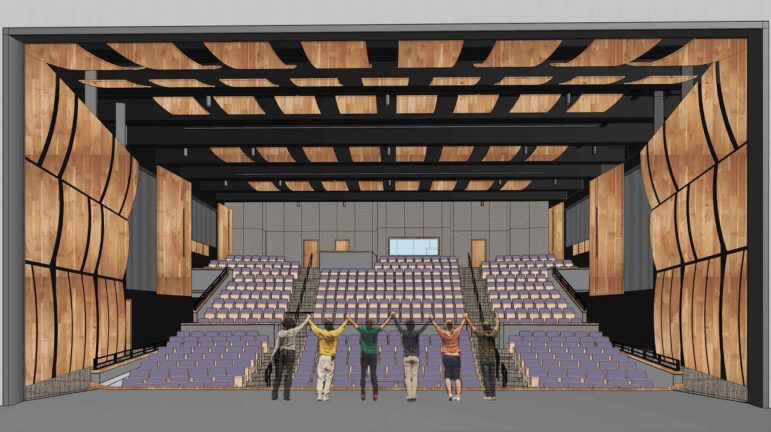
Theater center stage 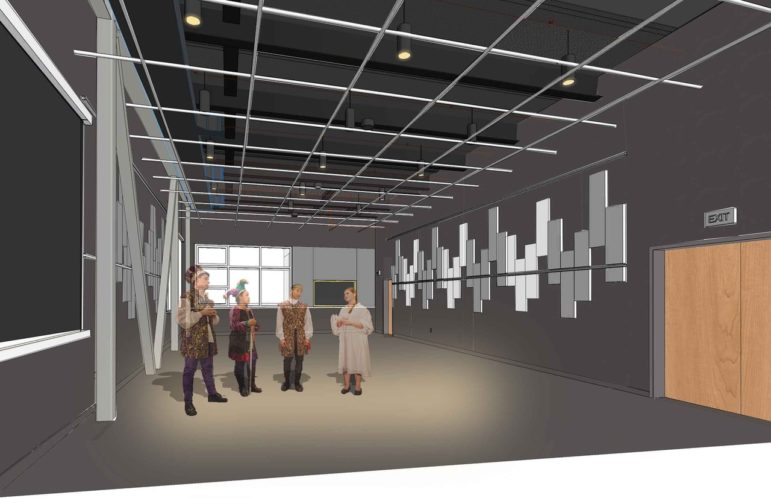
Drama classroom
- Replacement of failing HVAC systems at the high school.
- Modernization of high school classrooms in the “20s” and “30s” buildings, and reconfiguration of old science labs to general classrooms.
- Replacement of the failing drainage system and turf and track at Witter Field, which are at the end of their useful life.
The District expects to complete the work listed above with the $66.1 million in Measure H1 bond funds, bond interest earnings, and an additional $4 million to $6 million in anticipated State matching funds.
2018-19 Progress Report
- Developing and Reducing Project Costs
This year, the District worked with its general contractor, Overaa Construction, and the District’s Facilities Steering Committee, to determine and reduce project costs for the STEAM and performing arts buildings.
Overaa was able to attract multiple, competitive bids for each category of work (such as mechanical, electrical, plumbing and roofing), including work that Overaa intends to self-perform. This competitive pricing is worth noting because of the difficulty that many public school construction programs are having attracting any bids.
Following a thorough review of the bids, District staff and the Facilities Steering Committee considered alternative “means and methods” of construction to reduce costs. This process also revealed instances where subcontractors inadvertently omitted scope or deviated from the project plans and specifications.
In consultation with the Committee, the District decided to defer certain work (such as the purchase of solar panels and equipping the drama classroom) and self-perform other work (such as site utilities work and landscaping) to reduce costs. The guiding consideration throughout this cost-reduction process was to save money without compromising educational programs or the student experience.
According to its report and recommendations to the Board of Education, the Facilities Steering Committee noted that this was a rigorous and transparent process that resulted in significant cost savings. The Committee unanimously recommended, and the Board approved, an agreement with Overaa to build the STEAM building and performing arts building for a “Guaranteed Maximum Price” (GMP) of $50 million. The rationale is discussed here. Although higher than originally estimated, the Committee determined that the STEAM and performing arts building budgets represent “best value” in the contemporary construction market.
- Factors Contributing to Increased Costs
The budgets for the STEAM and performing arts buildings are significantly higher than originally estimated by the District and its independent cost estimators. This is due to several factors: extraordinary inflation and market conditions; changes in project scope mandated by the State; and changes in project scope elected by the District.
The preliminary theater budget was developed in early 2016, based on “comparable” theater projects in the area that were underway or completed in 2014 and 2015. Those “comps” do not reflect the recent surge in costs of construction materials and labor, or the additional structural steel and concrete elements required by the State for an open-interior structure in close proximity to the Hayward Fault.
To a lesser extent, the increased costs relate to increases in project scope, including complex systems to achieve “zero-net-energy” buildings, and a drama classroom and meeting room in the theater building. The Facilities Steering Committee discussed these scope increases and determined that they are necessary to: meet community goals concerning sustainability and conservation; support the performing arts programs; and protect the theater from the undue wear and tear of daily use as a classroom. Specifically, the Committee concluded that failing to incorporate state-of-the-art energy efficient systems and the additional theater space would be short-sighted, because it would fail to meet current and future program needs, and because it would result in higher operating, maintenance, and replacement costs over time.
- Deferral of Other Projects
After establishing the GMP for the STEAM and performing arts building projects, and in consultation with the Facilities Steering Committee, the District decided to defer other major projects until State matching funds become available.
- Witter Field
The turf and track at Witter Field were last replaced in 2007 and are at the end of their useful life. A more fundamental problem, and more time-consuming and expensive to fix, is the field’s underground drainage system. The system has failed and, as a result, rain water typically pools both above and below the synthetic turf. As a result, even moderate rain can lead to field closure. The cost of replacing the drainage system, installing new turf and track, and making accessibility improvements is roughly $3.4 million, and this cost will be covered primarily by State modernization funds.
The District took all steps necessary to prepare for the Witter Field project, including: site surveys and analysis; engineering and plan development; application for a permit; and issuance of a Request for Qualifications/Proposals for field contractors. Also, the District did relocation planning for athletics and graduations so it would have the option to proceed with the project this Spring. Nonetheless, because completion of the STEAM and theater buildings and modernization of the 20s and 30s buildings will likely consume the remaining bond funds, the District will use State modernization and other funds to complete the Witter renovation. For this reason, the Board decided to defer the Witter project for at least one year and until there is a more clear timeframe for disbursement of State funds.
- Extended-Day Kindergarten
Two years ago, the District started offering extended-day kindergarten at each elementary school. The District is considering the feasibility of expanding the kindergarten facilities. Nonetheless, there are numerous challenges to expanding the footprint of classrooms and adding restrooms within existing buildings, so these types of improvements will take time to plan and implement. Given that the extended-day kindergarten programs are already in place and that school enrollment is below capacity, the District will defer kindergarten expansion at least until the STEAM and performing arts building projects and improvements to the 20s and 30s buildings have been completed.
- Closure of Alan Harvey
The District closed Alan Harvey Theater in March, rather than waiting until the end of the school year, to help keep the STEAM project on schedule for completion before the 2020-21 school year. Starting immediately after closure, the District “salvaged” and removed fixtures, lighting systems, and other features that will be reused in the new theater. After salvage, a specialized contractor abated and removed hazardous materials and readied the building for demolition. (For the plans to abate and remove hazardous materials from the theater, see the H1 update dated March 27, 2019, the presentation by environmental hygienist Mark Milani at the Board of Education meeting on March 27, 2019 [starting at 52 minutes], and the related FAQ dated October 2018). All abatement and removal was completed, and inspected by the Bay Area Air Quality Management District (both during and after the work) and Cal/OSHA, and both oversight agencies noted compliance with applicable laws and regulations.
During the time the theater is closed, from March 2019 through the Fall of 2021, the District will relocate acting classes and performances to Haven’s Ellen Driscoll Theater, Piedmont Middle School’s Multi-Purpose Room, the City’s Veterans Hall and Community Hall, or other nearby venues. The Piedmont Adult School, formerly located in the basement of Alan Harvey Theater, has relocated to the 20s building. The District’s Shipping & Receiving Department, too, was formerly in the basement of Alan Harvey Theater, and will be in temporary locations until it eventually moves into the 40s building after the STEAM building is completed. The College & Career Center, formerly in the 20s building, has relocated into the PHS Counseling Office.
- Changes to Parking and Traffic Along Magnolia Avenue
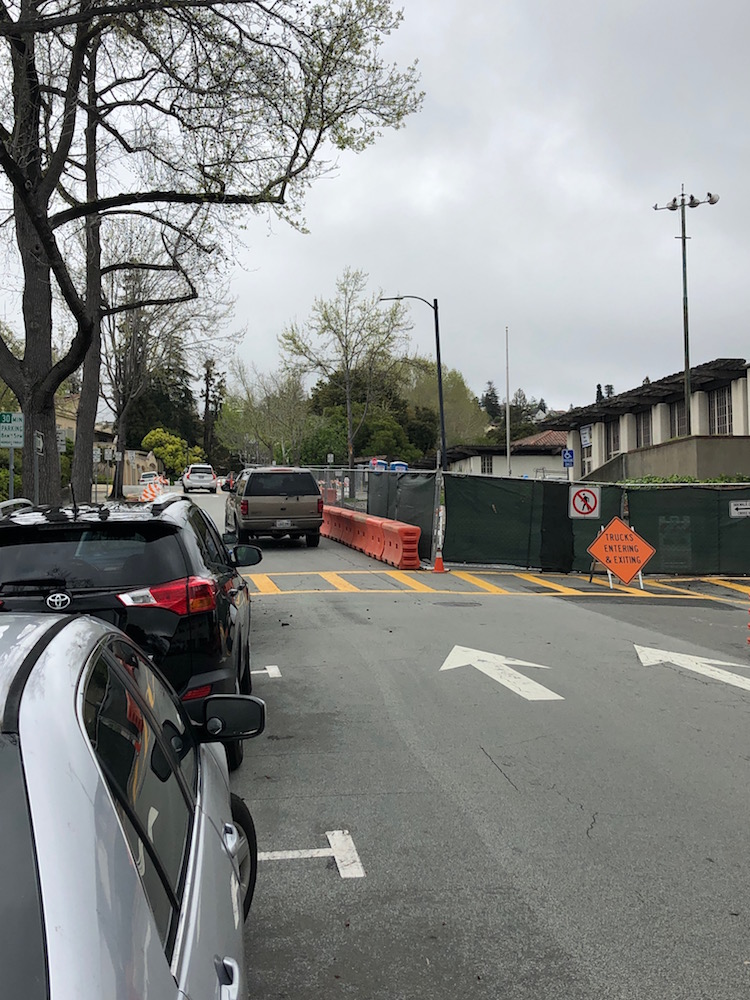
The District worked with the City of Piedmont to plan for and mitigate the demolition- and construction-related impacts on parking and traffic along Magnolia Avenue. The District is urging families to avoid Magnolia Avenue between Hillside Avenue and Highland Avenue if possible. For those who need to drop off or pick up students on Magnolia, all drop-off and pick-up — for PHS, MHS, and PMS — is in the designated loading/unloading area in front of PMS and the 40s building, which is now a large “white zone.”
- Demolition and Start of Construction
Demolition of Alan Harvey Theater started over Spring Break, when students and staff were off campus, and was completed soon after (see progress photos below). To mitigate the impact on students, staff, and campus flow, the theater site has been cordoned off from the rest of the campus. There is a fence enclosing the work areas with gates that remain locked during non-working hours. Access to the site is limited to authorized construction personnel only, and security cameras monitor the site 24 hours per day.
Throughout demolition and construction, the District will follow industry and legal standards to mitigate noise and dust and screen the staging and work areas. Also, the team has implemented a Pollution Prevention Program to filter dirt and debris from water that flows from the site into the storm drain.
Demolition of the original Alan Harvey Theater and the first phase of grading (including ensuring that the basement pad is properly compacted and at precisely the correct elevation) have now been completed on schedule with no surprises. Work is now underway on the STEAM building foundation. Overaa is digging footings, installing “rock anchors” 30 feet into the ground, and framing the basement retaining walls. Work on the foundation will continue throughout the summer and into the fall.
Summer 2019
Although it will be not be visible once completed, extensive underground work will be completed this summer. This underground work includes an unusually stout STEAM building foundation, because the site is so close to the Hayward Fault. The underground work also includes utilities work for both the STEAM and new performing arts buildings, including the rerouting of sewer, storm, fire sprinkler, power, water, gas and data/fiber/fire alarm lines and the relocation of the central Fire Alarm Control Panel. The underground utilities work for both buildings will be completed by the start of the 2019-20 school year, and the STEAM foundation will be completed in early October 2019.
Because this summer work will be largely underground, passersby may not see or perceive progress. Starting in October, when Overaa installs the structural steel, the community will be able to see the building begin to take shape.
Other work this summer will include installation of new, highly-energy-efficient climate control systems in the PHS Library building, making it possible to retire an old boiler that is well beyond its useful life. Summer work will also include resurfacing of the Piedmont Middle School sport courts, and this work will be funded by the City of Piedmont. The sport courts will be available for pickleball and other community uses outside of school hours.
Financial Summary
The Measure H1 bond authorization is $66.1 million and the District sold the first tranche of bonds in 2016, raising $26 million. The District earns roughly $20,000 per month in interest on this bond money, and interest earnings now total roughly $360,000.
Although high school construction did not start until recently, bond funds were needed during 2016-17 and 2017-18 to pay for “soft costs” such as design, engineering, surveys, program/construction management, and improvements on other campuses (see the list of completed projects above, at page 3). The District expended $685,285 during 2016-17 (including $143,896 in “reimbursement” to the General Fund for pre-bond expenditures during the 2015-16 fiscal year), leaving a balance of $25,314,855 (including interest earnings) on June 30, 2017. (For more information, see the Citizens’ Bond Oversight Committee’s First Annual Report to the Community dated March 2018.)
The District expended $3,683,170 during 2017-18, leaving a balance of $21,941,002 (including interest earnings) on June 30, 2018. (For more information, see the Citizens’ Bond Oversight Committee’s Second Annual Report to the Community dated March 2019.)
As of today’s date, the District expended roughly $ 2,629,965 and encumbered an additional $2,839,951 during the 2018-19 school year, leaving a balance of roughly $16,788,315 (including interest earnings) from the first bond sale. The precise amounts will be confirmed in the independent audits conducted after the end of the fiscal year, and reviewed by the District’s Citizens Bond Oversight Committee.
The District plans to the sell the remaining Measure H1 bonds in one or two tranches, depending on cash demand. The District will use one tranche if possible, to reduce transaction costs. Based in part on the projected growth in assessed real property values in Piedmont, the District expects the H1 bonds to be fully repaid around the year 2045.
